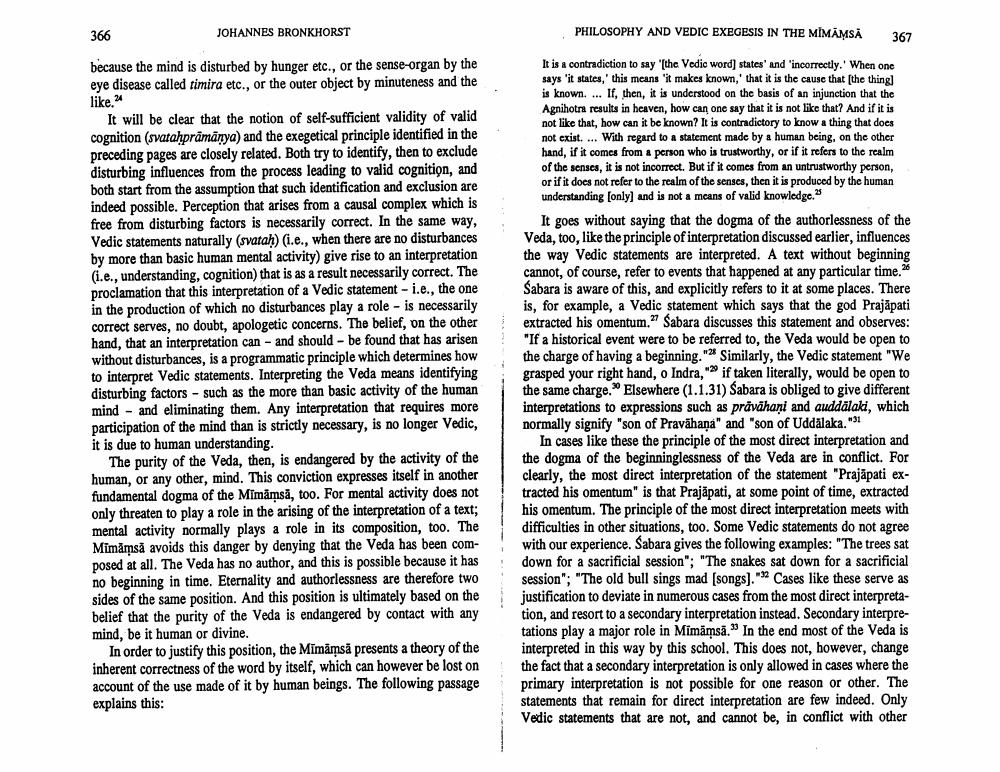________________
JOHANNES BRONKHORST
366
because the mind is disturbed by hunger etc., or the sense-organ by the eye disease called timira etc., or the outer object by minuteness and the like.24
It will be clear that the notion of self-sufficient validity of valid cognition (svataḥprāmānya) and the exegetical principle identified in the preceding pages are closely related. Both try to identify, then to exclude disturbing influences from the process leading to valid cognition, and both start from the assumption that such identification and exclusion are indeed possible. Perception that arises from a causal complex which is free from disturbing factors is necessarily correct. In the same way, Vedic statements naturally (svatah) (i.e., when there are no disturbances by more than basic human mental activity) give rise to an interpretation (i.e., understanding, cognition) that is as a result necessarily correct. The proclamation that this interpretation of a Vedic statement - i.e., the one in the production of which no disturbances play a role is necessarily correct serves, no doubt, apologetic concerns. The belief, on the other hand, that an interpretation can and should be found that has arisen without disturbances, is a programmatic principle which determines how to interpret Vedic statements. Interpreting the Veda means identifying disturbing factors such as the more than basic activity of the human mind and eliminating them. Any interpretation that requires more participation of the mind than is strictly necessary, is no longer Vedic, it is due to human understanding.
The purity of the Veda, then, is endangered by the activity of the human, or any other, mind. This conviction expresses itself in another fundamental dogma of the Mimämsä, too. For mental activity does not only threaten to play a role in the arising of the interpretation of a text; mental activity normally plays a role in its composition, too. The Mimämsä avoids this danger by denying that the Veda has been composed at all. The Veda has no author, and this is possible because it has no beginning in time. Eternality and authorlessness are therefore two sides of the same position. And this position is ultimately based on the belief that the purity of the Veda is endangered by contact with any mind, be it human or divine.
In order to justify this position, the Mimämsä presents a theory of the inherent correctness of the word by itself, which can however be lost on account of the use made of it by human beings. The following passage explains this:
PHILOSOPHY AND VEDIC EXEGESIS IN THE MIMAMSA
It is a contradiction to say '[the Vedic word] states' and 'incorrectly.' When one says 'it states, this means 'it makes known,' that it is the cause that [the thing] is known.... If, then, it is understood on the basis of an injunction that the Agnihotra results in heaven, how can one say that it is not like that? And if it is not like that, how can it be known? It is contradictory to know a thing that does not exist. ... With regard to a statement made by a human being, on the other hand, if it comes from a person who is trustworthy, or if it refers to the realm of the senses, it is not incorrect. But if it comes from an untrustworthy person, or if it does not refer to the realm of the senses, then it is produced by the human understanding [only] and is not a means of valid knowledge.25
367
It goes without saying that the dogma of the authorlessness of the Veda, too, like the principle of interpretation discussed earlier, influences the way Vedic statements are interpreted. A text without beginning cannot, of course, refer to events that happened at any particular time.26 Sabara is aware of this, and explicitly refers to it at some places. There is, for example, a Vedic statement which says that the god Prajapati extracted his omentum." Sabara discusses this statement and observes: "If a historical event were to be referred to, the Veda would be open to the charge of having a beginning."2 Similarly, the Vedic statement "We grasped your right hand, o Indra," if taken literally, would be open to the same charge. Elsewhere (1.1.31) Śabara is obliged to give different interpretations to expressions such as prävähani and auddälaki, which normally signify "son of Pravahana" and "son of Uddälaka. "31
In cases like these the principle of the most direct interpretation and the dogma of the beginninglessness of the Veda are in conflict. For clearly, the most direct interpretation of the statement "Prajapati extracted his omentum" is that Prajapati, at some point of time, extracted his omentum. The principle of the most direct interpretation meets with difficulties in other situations, too. Some Vedic statements do not agree with our experience. Sabara gives the following examples: "The trees sat down for a sacrificial session"; "The snakes sat down for a sacrificial session"; "The old bull sings mad [songs]."2 Cases like these serve as justification to deviate in numerous cases from the most direct interpretation, and resort to a secondary interpretation instead. Secondary interpretations play a major role in Mimämsä." In the end most of the Veda is interpreted in this way by this school. This does not, however, change the fact that a secondary interpretation is only allowed in cases where the primary interpretation is not possible for one reason or other. The statements that remain for direct interpretation are few indeed. Only Vedic statements that are not, and cannot be, in conflict with other




